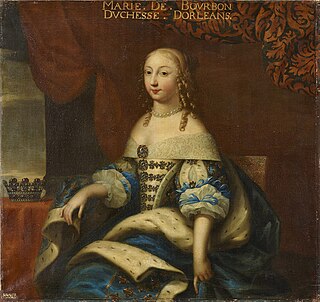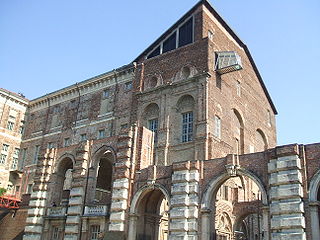
Henri, Count of Chambord was disputedly King of France from 2 to 9 August 1830 as Henry V, although he was never officially proclaimed as such. Afterwards, he was the Legitimist pretender to the throne of France from 1844 to 1883. He was nearly received as king in 1871 and 1873.
The Most Serene House of Condé was a French princely house and a cadet branch of the House of Bourbon. The name of the house was derived from the title of Prince of Condé that was originally assumed around 1557 by the French Protestant leader, Louis de Bourbon (1530–1569), uncle of King Henry IV of France, and borne by his male-line descendants.

Gaston, Duke of Orléans, was the third son of King Henry IV of France and his wife Marie de' Medici. As a son of the king, he was born a Fils de France. He later acquired the title Duke of Orléans, by which he was generally known during his adulthood. As the eldest surviving brother of King Louis XIII, he was known at court by the traditional honorific Monsieur.

Louis de Bourbon, or Louis III, Prince of Condé, was a prince du sang as a member of the reigning House of Bourbon at the French court of Louis XIV. Styled as the Duke of Bourbon from birth, he succeeded his father as Prince of Condé in 1709; however, he was still known by the ducal title. He was prince for less than a year.

Henri Eugène Philippe Louis d'Orléans, Duke of Aumale was a leader of the Orleanists, a political faction in 19th-century France associated with constitutional monarchy. He was born in Paris, the fifth son of King Louis-Philippe I of the French and Maria Amalia of Naples and Sicily. He used the title Duke of Aumale. He retired from public life in 1883.

Charles de Lorraine, 4th Duke of Guise was the son of Henry I, Duke of Guise and Catherine of Cleves.

Louis de Lorraine, Duke of Joyeuse was a younger son of Charles, Duke of Guise and Henriette Catherine de Joyeuse.

Jean Louis de Nogaret de La Valette (1554–1642), created Duke of Épernon, was a powerful member of the French nobility at the turn of the 16th century. He was deeply involved in plots and politics throughout his life.

François de Joyeuse was a French churchman and politician.

Anne de Batarnay de Joyeuse, Baron d'Arques, Vicomte then Duke of Joyeuse was a royal favourite and active participant in the French Wars of Religion.

Marie de Bourbon, Duchess of Montpensier, and Duchess of Orléans by marriage, was a French noblewoman and one of the last members of the House of Bourbon-Montpensier. Her parents were Henri de Bourbon, Duke of Montpensier and Henriette Catherine de Joyeuse, Duchess of Joyeuse in her own right.

A prince du sang is a person legitimately descended in dynastic line from any of a realm's hereditary monarchs. Historically, the term has been used to refer to men and women descended in the male line from a sovereign, although as absolute primogeniture has become more common in monarchies, those with succession rights through female descent are more likely than in the past to be accorded the princely title.

The House of Bourbon-Montpensier or Maison de Bourbon-Montpensier was a semi royal family. The name of Bourbon comes from a marriage between Marie de Valois, comtesse de Montpensier (1375–1434) who married Jean de Bourbon - the duc de Bourbon. The second name of Montpensier, comes from the title of the family.

Élisabeth Marguerite d'Orléans, known as Isabelle d'Orléans, was the Duchess of Alençon and, during her husband's lifetime, Duchess of Angoulême. She was a daughter of Gaston d'Orléans and a first cousin of Louis XIV of France. She has no descendants today. She was suo jure Duchess of Alençon and Angoulême.

Duke of Fronsac was a title of French nobility, first created by promoting the seigneurie of Fronsac to a duchy in 1608, but the title became extinct a few decades later. This title was revived for Armand Jean du Plessis de Richelieu, better known as Cardinal Richelieu, in 1634, surviving until the 19th century.
The Viscounty of Joyeuse was elevated to a Duchy in 1581 by King Henry III of France for his favourite Anne de Joyeuse.
Duc de Piney was a title in the Peerage of France. The holders were also sometimes called duc de Luxembourg, after the House of Luxembourg, from whom they were descended.

François de Bourbon was the Duke of Montpensier and member of the House of Bourbon. He was the brother of Charlotte de Bourbon, Princess of Orange and wife of William the Silent, Prince of Orange. He was the great grandfather of La Grande Mademoiselle cousin of Louis XIV.
Claude Billard was a French writer, poet and playwright of the Renaissance.



















